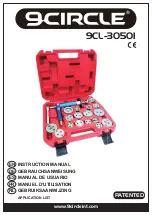
12
Always use a blade suited to the material and material thickness
to be cut. Always ensure the work–piece is firmly held or clamped
to prevent movement.
For easier control, use a low speed to start cutting, then increase
to correct speed. Any movement of the material may affect the
quality of the cut. Clearly mark the work-piece to locate the
position of the cut.
Once the jigsaw has reached the desired speed, gradually bring
the moving blade into contact with the work-piece at the
appropriate location.
Apply enough downward pressure to keep the jigsaw steady and
only enough forward pressure to keep the blade cutting freely.
The blade cuts on the upward stroke and may chip the uppermost
surface or face of the work piece. Ensure your uppermost surface
is a non-visible surface when your work is finished.
Straight cut
: A straight cut can be made by clamping a piece of
wood or straightedge to the work-piece and guiding the edge of the
saw against it. Make the cut from one direction only. Do not cut
halfway and complete the cut from the opposite end.
Bevel cutting
(Angle Cutting): Bevel cutting angles may be adjusted
from 0° to 45° either left or right. To adjust the bevel angle, follow
the steps provided on the ‘Base Plate Adjustment’ section on the
previous page.
Scroll cutting:
Scroll cuts can be made with the jig saw by guiding
the direction of the cut with applied pressure on the handle.
GENERAL OPERATION
IBL JS10-70
WARNING!
Designate a work area that is clean and well-lit.
Route the power cord along a safe route to reach the work area
without creating a tripping hazard or exposing the power cord to
possible damage.
Secure loose work pieces using a vice or clamps to prevent
movement while working.
Refer specific instructions on page no. 6 before operation
.
Summary of Contents for JS10-70
Page 1: ...JS10 70 JIG SAW ...
Page 2: ...1 ...



































